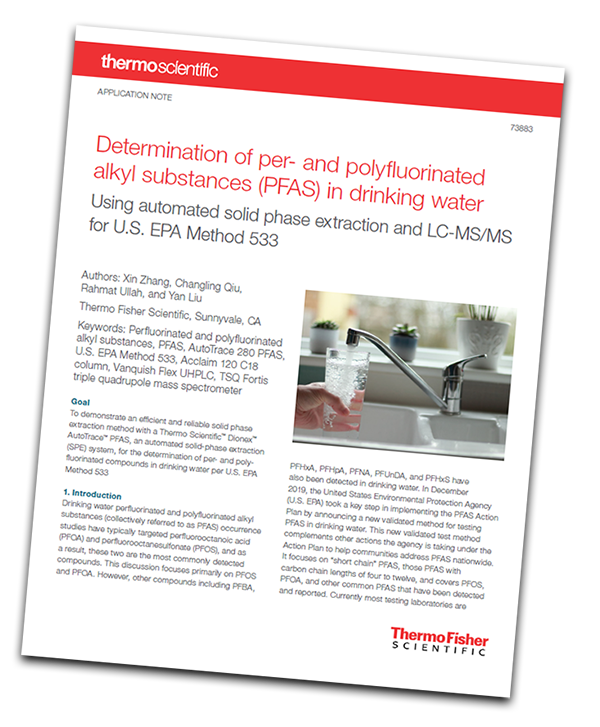This application note demonstrates how Thermo Scientific Dionex CarboPac PA300-4µm column allows simplified, high-resolution sorbitol separation and quantification in complex samples.
 Goal
Goal
To demonstrate an efficient and reliable solid phase extraction method with a Thermo Scientific™ Dionex™ AutoTrace™ PFAS, an automated solid-phase extraction (SPE) system, for the determination of per- and polyfluorinated compounds in drinking water per U.S. EPA Method 533
Introduction
Drinking water perfluorinated and polyfluorinated alkyl substances (collectively referred to as PFAS) occurrence studies have typically targeted perfluorooctanoic acid (PFOA) and perfluorooctanesulfonate (PFOS), and as
a result, these two are the most commonly detected compounds. This discussion focuses primarily on PFOS and PFOA. However, other compounds including PFBA, PFHxA, PFHpA, PFNA, PFUnDA, and PFHxS have also been detected in drinking water. In December 2019, the United States Environmental Protection Agency (U.S. EPA) took a key step in implementing the PFAS Action Plan by announcing a new validated method for testing PFAS in drinking water. This new validated test method complements other actions the agency is taking under the Action Plan to help communities address PFAS nationwide. It focuses on “short chain” PFAS, those PFAS with carbon chain lengths of four to twelve, and covers PFOS, PFOA, and other common PFAS that have been detected and reported. Currently most testing laboratories are performing the sample extraction manually using a vacuum manifold, which is labor-intensive and time-consuming.
In addition, the flow rate through the cartridge is difficult to control, which may yield low recoveries or cause false negatives. There is a high demand for automation of the SPE procedure. Here we discuss the development of an analytical method using an automated SPE system and LC-MS/MS for determination of twenty-five PFAS compounds following the guidelines provided by U.S. EPA Method 533. We have demonstrated that the automated SPE system provides reliable determination of PFAS in large-volume aqueous samples and saves time, solvent, and labor, while ensuring high reproducibility and productivity for analytical testing laboratories.
Experimental
Full details of the experimental conditions can be found by downloading the application note.
Results and Discussion
Demonstration of low system background
Due to the wide usage of PFAS, it is necessary to demonstrate low system background from consumables such as sample containers, tubing, SPE cartridges, and separation columns to instruments including the SPE auto extraction system, LC, and MS. A blank experiment was designed that consisted of reagent water going through the workflow.
Conclusion
We proposed and demonstrated a PFAS-inert automated SPE extraction LC-MS/MS system that can be used for the simultaneous extraction and determination of twenty-five PFAS in drinking water. The PFAS-inert material modified auto SPE system ensures inertness and prevents PFAS from leaching into sample during extraction; while at the same time delivering labor-and-time-efficient, consistent, and reliable performance. Full method validation has been successfully performed with both a reagent water and a finished drinking water sample. Acceptable low background, LCMRLs, calibration range, coefficient of determination and % deviation, precision, and accuracy for both tested analytes and isotope dilution analogue recoveries demonstrated the auto sample preparation system and UHPLC-MS/MS workflow as an efficient and reliable method to fulfill U. S. EPA Method 533 requirements.
